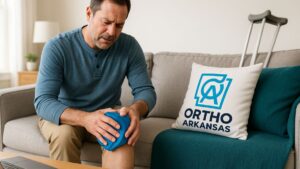Tenderness, stiffness, burning, aches near the heel—and even leg pain—are all symptoms of plantar fasciitis. Affecting one in ten people in the United States, this common foot condition can cause significant pain and limit the daily activities of its sufferers. While plantar fasciitis is a real pain in the foot, and the recurring pain can be frustrating for patients, there is hope— and non-surgical methods manage the condition.
What Is Plantar Fasciitis?
The plantar fascia is a web-like ligament on the bottom of the foot. It has three parts that start from the heel bone and are vital for supporting the foot’s structure, maintaining normal movement, and absorbing shock. As a person stands and the arch drops, the foot lengthens and stretches, putting strain on the plantar fascia. Over time, this can lead to microtrauma, structural damage, and pain.
Causes
Although the condition has various causes, excessive stress from overuse is the most common factor, resulting in sharp pain in the heel and sometimes heel spurs. Other causes include weight gain, loss of the foot’s fat pad, and overpronation, all of which increase stress on the plantar fascia. Despite its name, however, this condition is not characterized by inflammation.
Footwear Precautions
Footwear also plays a significant role in causing plantar fasciitis. Among the majority of diagnosed cases, patients wore inappropriate shoes with minimal heel height, thin soles, and hard insole without any built-in arch support. Properly fitting shoes with arch support, cushion, and a deep heel cup are recommended.
Symptoms
The main sign of plantar fasciitis is pain, often felt on the bottom of the heel when standing up. Moving around may temporarily ease the pain, but extended activity can worsen it. For persistent foot pains, do not ignore it or try to “walk it off”— this often causes more damage that was otherwise preventable.
Leg Pain and Plantar Fasciitis
Plantar fasciitis can also cause pain to spread up the leg. Nerve pain in the heel area can lead to pain in the ankle and calf. In addition, changes in how the lower body moves due to pain can lead to injuries from overuse or pain in the lower and upper leg, hip, and back.
Common Treatments for Plantar Fasciitis
Treatment options for plantar fasciitis can vary depending on the individual and the severity of their condition. Common non-surgical approaches include rest, ice therapy, stretching exercises, orthotic inserts, and supportive footwear. In some cases, physical therapy or steroid injections may be recommended. In severe cases, surgery is sometimes the best option for lasting relief.
Remember, early intervention and monitoring your condition is the best route to a successful recovery and long-term relief. An appointment with an orthopedic expert can get to the root cause of your foot pain and set you on the path to relief.













